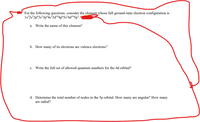
Chemistry
10th Edition
ISBN: 9781305957404
Author: Steven S. Zumdahl, Susan A. Zumdahl, Donald J. DeCoste
Publisher: Cengage Learning
expand_more
expand_more
format_list_bulleted
Concept explainers
Question
- For the following questions, consider the element whose full ground-state electron configuration is
1s22s22p63s23p64s23d104p65s24d105p5.
- Write the name of this element?
- How many of its electrons are valence electrons?
- Write the full set of allowed quantum numbers for the 4d orbital?
- Determine the total number of nodes in the 5p orbital. How many are angular? How many are radial?

Transcribed Image Text:For the following questions, consider the element whose full ground-state electron configuration is
1s°2s²2p°3s²3p°4s?3d!º4p°5s²4d!©5p% •
а.
Write the name of this element?
b. How many of its electrons are valence electrons?
c. Write the full set of allowed quantum numbers for the 4d orbital?
d. Determine the total number of nodes in the 5p orbital. How many are angular? How many
are radial?
Expert Solution
arrow_forward
Step 1
Electrons that are present in the outermost shell are called valance electrons.
Step by stepSolved in 3 steps

Knowledge Booster
Learn more about
Need a deep-dive on the concept behind this application? Look no further. Learn more about this topic, chemistry and related others by exploring similar questions and additional content below.Similar questions
- Don't use Ai for answering thisarrow_forwardHow many electrons in an atom could have these sets of quantum numbers? n = 3 electrons n = 5, € = 1 electrons n = 7,€ = 3, me = -1 electronsarrow_forwardThe Pauli Exclusion Principle tells us that no two electrons in an atom can have the same four quantum numbers. For an electron in the 3p orbital shown above, enter a possible value for each quantum number. n = Give ONE example. mį = Give ONE example. Though a given electron only has one value for there are mi, O possible mį values for electrons in 3p orbitals.arrow_forward
- An electron has the following set of quantum numbers: 3, 2, -1, -12. L L L What is the energy level for this electron? What type of orbital is represented by these quantum numbers? Which of the following atoms could have an electron in the ground state with these quantum numbers?arrow_forwardWhich of the following subshells has room for 10 electrons? 5s 4p 2p 3d 3parrow_forwardFor each of the following sets of quantum numbers, determine how many electrons in a single atom could have that specific set of numbers. n = 2 Number: n = 4, l=1 Number: n = 5,l=1, m₁ = 0 Number: electrons electrons electronsarrow_forward
- In one atom, what is the maximum number of electrons that could have the quantum number of n = 3? electrons 1 3 4 6. C 7 8 9. +/- х 100 +arrow_forwardHi! Wouldn't there only be five answers (and not 10) for the quantum numbers since the electrons in the d-orbitals are unpaired?arrow_forwardFix any errors in these proposed electron configurations. number of electrons in atom 16 5 26 proposed electron configuration 6 15 1p 2s 2p 15²25²35²¹ 15 25 2p 3s 3p 3darrow_forward
- please solve question 1 and 2, thanks alot sirarrow_forwardThe Pauli Exclusion Principle tells us that no two electrons in an atom can have the same four quantum numbers. In progress For an electron in the 3s orbital shown above, enter a possible value for each quantum number. n = 1 = = Give ONE example. Give ONE example. Though a given electron only has one value for possible mi, there are my values for electrons in 3s orbitals. m₁ = ms = Submit Answer Retry Entire Group 9 more group attempts remainingarrow_forward
arrow_back_ios
arrow_forward_ios
Recommended textbooks for you
 ChemistryChemistryISBN:9781305957404Author:Steven S. Zumdahl, Susan A. Zumdahl, Donald J. DeCostePublisher:Cengage Learning
ChemistryChemistryISBN:9781305957404Author:Steven S. Zumdahl, Susan A. Zumdahl, Donald J. DeCostePublisher:Cengage Learning ChemistryChemistryISBN:9781259911156Author:Raymond Chang Dr., Jason Overby ProfessorPublisher:McGraw-Hill Education
ChemistryChemistryISBN:9781259911156Author:Raymond Chang Dr., Jason Overby ProfessorPublisher:McGraw-Hill Education Principles of Instrumental AnalysisChemistryISBN:9781305577213Author:Douglas A. Skoog, F. James Holler, Stanley R. CrouchPublisher:Cengage Learning
Principles of Instrumental AnalysisChemistryISBN:9781305577213Author:Douglas A. Skoog, F. James Holler, Stanley R. CrouchPublisher:Cengage Learning Organic ChemistryChemistryISBN:9780078021558Author:Janice Gorzynski Smith Dr.Publisher:McGraw-Hill Education
Organic ChemistryChemistryISBN:9780078021558Author:Janice Gorzynski Smith Dr.Publisher:McGraw-Hill Education Chemistry: Principles and ReactionsChemistryISBN:9781305079373Author:William L. Masterton, Cecile N. HurleyPublisher:Cengage Learning
Chemistry: Principles and ReactionsChemistryISBN:9781305079373Author:William L. Masterton, Cecile N. HurleyPublisher:Cengage Learning Elementary Principles of Chemical Processes, Bind...ChemistryISBN:9781118431221Author:Richard M. Felder, Ronald W. Rousseau, Lisa G. BullardPublisher:WILEY
Elementary Principles of Chemical Processes, Bind...ChemistryISBN:9781118431221Author:Richard M. Felder, Ronald W. Rousseau, Lisa G. BullardPublisher:WILEY

Chemistry
Chemistry
ISBN:9781305957404
Author:Steven S. Zumdahl, Susan A. Zumdahl, Donald J. DeCoste
Publisher:Cengage Learning

Chemistry
Chemistry
ISBN:9781259911156
Author:Raymond Chang Dr., Jason Overby Professor
Publisher:McGraw-Hill Education

Principles of Instrumental Analysis
Chemistry
ISBN:9781305577213
Author:Douglas A. Skoog, F. James Holler, Stanley R. Crouch
Publisher:Cengage Learning

Organic Chemistry
Chemistry
ISBN:9780078021558
Author:Janice Gorzynski Smith Dr.
Publisher:McGraw-Hill Education

Chemistry: Principles and Reactions
Chemistry
ISBN:9781305079373
Author:William L. Masterton, Cecile N. Hurley
Publisher:Cengage Learning

Elementary Principles of Chemical Processes, Bind...
Chemistry
ISBN:9781118431221
Author:Richard M. Felder, Ronald W. Rousseau, Lisa G. Bullard
Publisher:WILEY